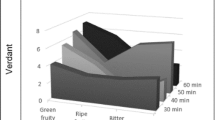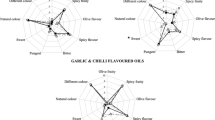Abstract
Winey-vinegary sensory defect was evaluated in virgin olive oil samples from a sensory and chemical point of view. Qualitative and quantitative differences were found in the profile of volatiles of extra-virgin olive oil samples without sensory defects and samples with high intensities of winey-vinegary sensory attribute. Several volatile compounds were found to be correlated to winey-vinegary sensory defect in virgin olive oils, acetic acid and ethyl acetate having correlation coefficients of 0.98 and 0.94 respectively. A synthetic sample was obtained with the sensory characteristics of the winey defect. Samples with low values of winey sensory defect were also studied and the evaluation of the presence of the defect using the content of four volatile compounds only was demonstrated.
Similar content being viewed by others
Author information
Authors and Affiliations
Additional information
Received: 5 August 1999 / Revised version: 22 October 1999
Rights and permissions
About this article
Cite this article
Morales, M., Luna, G. & Aparicio, R. Sensory and chemical evaluation of winey-vinegary defect in virgin olive oils. Eur Food Res Technol 211, 222–228 (2000). https://doi.org/10.1007/s002170050028
Issue Date:
DOI: https://doi.org/10.1007/s002170050028




